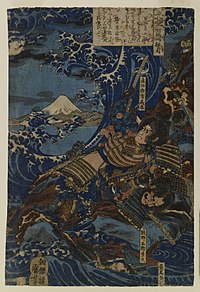Battle of Ishibashiyama
You can help expand this article with text translated from the corresponding article in Japanese. (September 2019) Click [show] for important translation instructions.
|
| Battle of Ishibashiyama | |||||||
|---|---|---|---|---|---|---|---|
| Part of the Genpei War | |||||||
 A 19th-century depiction of combat on the rocky shore at Ishibashiyama | |||||||
| |||||||
| Belligerents | |||||||
|
|
| ||||||
| Commanders and leaders | |||||||
|
| |||||||
| Strength | |||||||
| 300 | 3,000 | ||||||
| Casualties and losses | |||||||
| unknown | unknown | ||||||
The Battle of Ishibashiyama (石橋山の戦い, Ishibashiyama no tatakai) was the first in which Minamoto no Yoritomo,[1] who became shōgun less than a decade later, was commander of the Minamoto forces. The battle was fought on September 14, 1180, in the southwest of present-day Odawara, Kanagawa Prefecture, near Yoritomo's headquarters at Kamakura.[2][3][4]
Background[edit]
Minamoto no Yoritomo was exiled by the leader of the Taira clan, Taira no Kiyomori, following the Heiji Rebellion of 1160. In the following years, the Taira clan attempted to consolidate their position, eventually forcing the Emperor Takakura to abdicate in favour of his infant son, Antoku, whose mother was a Taira. Prince Mochihito, brother of Emperor Takakura, felt that the Taira had denied his rightful claim to the throne, and in May 1180, issued an appeal to the Minamoto clan to rise against the Taira.[5] As Yorimoto was married into the Hōjō clan, they helped fund his petition to claim himself as the head of the Minamoto clan.[4]
When Kiyomori heard that Yoritomo had left Izu Province for the Hakone Pass, he appointed Ōba Kagechika to stop him. Although there was much sympathy for Yoritomo's call to arms, the clans were wary of openly supporting him, and an army of only 300 gathered at Ishibashiyama where he had raised his standard. A force from the Miura clan, was prevented from reaching Yoritomo due to poor weather conditions which caused the Sakawa River near Kamakura to flood.[6]
Battle[edit]
Ōba Kagechika launched a night attack on the Minamoto camp with 3,000 men during a heavy rainstorm. A further 300 soldiers under the command of Itō Sukechika skirted around the camp, attacking the Minamoto forces in the rear to cut off their way of retreat. At the same time the defenders were aided by members of Ōba's forces who's loyalties were questionable, and they decided to disrupt the assault against the Minamoto, using the dark and stormy conditions to avoid detection. Despite being greatly outnumbered, the soldiers of the Minamoto clan put up a valiant defense.[4]
In the midst of the battle, Yoritomo's brother-in-law Hōjō Munetoki, was killed. The imbalance in numbers between the two armies eventually forced Yoritomo to retreat, supposedly culminating in a last stand by Yoritomo and a single retainer by the trunk of a hollow tree. It is said that when they realized all was lost, Yoritomo and his companion hid inside the tree. Later, they are said to have been found by a Minamoto sympathizer serving in Ōba's army and then successfully smuggled out of harms way.[7] Yoritomo then fled by sea from Cape Manazuru to the Bōsō Peninsula in Awa Province[8] in the south of present-day Chiba Prefecture on September 28, 1180.[2]
References[edit]
- ^ Turnbull, Stephen (1998). The Samurai Sourcebook. Cassell & Co. p. 200. ISBN 1854095234.
- ^ a b "Shibayama-machi". Nihon Daihyakka Zensho (Nipponika) (in Japanese). Tokyo: Shogakukan. 2012. Archived from the original on 25 August 2007. Retrieved 9 May 2012.
- ^ "Ishibashiyama". Dijitaru daijisen (in Japanese). Tokyo: Shogakukan. 2012. Archived from the original on 25 August 2007. Retrieved 9 May 2012.
- ^ a b c kato. "The Battle of Ishibashiyama, 1180". Samurai World (in Japanese). Retrieved 2021-02-28.
- ^ Sansom, George (1958). A History of Japan to 1334. Stanford University Press. pp. 259–260, 275, 278, 285, 289. ISBN 0804705232.
- ^ De Benneville, James S. (1910). Saitō Musashi-bō Benkei: Tales of the Wars of the Gempei. pp. 28–29.
- ^ De Benneville, pp. 29-30
- ^ Turnbull, Stephen (1977). The Samurai, A Military History. MacMillan Publishing Co., Inc. p. 15. ISBN 0026205408.
